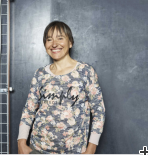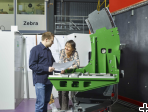Copyright 2012 neutronsources.org | All rights reserved. | Powered by FRM II | Imprint / Privacy Policy
Zebra - a new instrument for the PSI
Date: 31/05/2016
Source: psi.ch
Interview with Oksana Zaharko
New scientific questions demand ever better experimental equipment. In this interview, PSI researcher Oksana Zaharko reports on the challenges of setting up a new instrument for research with neutrons.
Dr. Zaharko, you’re building a new instrument called Zebra at the Paul Scherrer Institute. What kind of instrument is it?
It’s a big machine, roughly the size of a car. It aims to study the atomic structure of materials. You place a sample in the machine and send a beam of particles – neutrons from the Swiss Spallation Neutron Source SINQ – through it. The beam that comes out of the sample then contains a lot of information about how the material is structured. In technical terms, Zebra is a single-crystal neutron diffractometer.
And how did Zebra get its name?
An instrument like this is on the one hand a workhorse, which has to be robust and work reliably. At the same time, it is something new, and its development needed imagination. So “zebra” fits very well: It is exotic in Switzerland, but nevertheless a kind of horse.
What can you find out with it?
Better understanding of how a material is assembled: of which atoms – the building blocks of matter – it is built, and how these atoms are arranged. Also, some atoms behave like tiny magnets, and there we can see how they are aligned. The goal is to understand how the properties of materials emerge.
What kinds of properties?
We can study, for example, why some materials are magnets. Or superconductors – that is, why they can conduct current without loss. Questions like these stand at the beginning of many technological developments that will, in the end, be used in technical devices: in the energy sector, in electronic components, and in many other applications.
Where does the idea of what kind of instrument to build come from?
From one side, the users, the researchers from other institutions who come here to do their experiments. They come with ideas for experiments, and then sometimes we have to say: That is interesting, but with the instrument that we now have, we can’t do it. At the same time, we here are scientists ourselves and have ideas and realize that we can’t implement them.
And when the idea is there?
Then we need to convince people at all levels of the institute, from laboratory heads to the director, who have a better overview and can assess how well the instrument fits into the overall strategy. We need funding. The Swiss National Science Foundation runs a program called R’Equip, which supports Swiss institutes in modernising their scientific facilities. But that fund finances only half of the costs. The rest has to come from the PSI. And we need to draw on the talent pool here, getting time commitments from colleagues at the PSI who will work on the project.
Where do you need the support of your colleagues?
We have, for example, design engineers who are drafting all the parts of Zebra, down to the smallest detail. For parts that can’t be purchased, they need to make precise plans and then we can order them. For example, at the PSI workshop. Here, then, electronic and mechanical technicians work on the project. Or we give it to a special company. But these things are really complex, and there you must first find a company that can do it as inexpensively as possible and as good as possible. That takes a lot of work.
Do you then look for the firms that will carry out the work?
No, I am the scientific manager; in the project there is a technical manager who does that. In the past we tried to develop instruments in such a way that the scientists did everything. That was not very efficient. One had to do two or three jobs in parallel and without having the necessary know-how in the beginning. Now I am the driving force, but the technical colleagues handle the implementation. They commission the parts and check that all of the details are there in the end. That makes communication among the participants even more important than before. Because it often isn’t enough for me to present the technical specifications. The components are so complex that the co-workers concentrate completely on the technical details and can occasionally lose view of the big picture. For this reason I need to stay involved and intervene when needed to say, Stop, stop. Don’t forget that in the end we want to do science with this instrument.
Do you collaborate mostly with Swiss companies?
We try to procure most of the parts nearby, and usually this works. I was unaware that there are so many good companies here in the vicinity. This really is high-tech. We only sometimes order components from far away in other countries, when there is a company that builds the exact part that we need, so we won’t have to develop it ourselves.
In what stage is Zebra now?
In mid-May, the neutron source of the PSI comes back on line after a pause of several months, and since the instrument will be complete, we can begin to test it. The first users are expected to come in June. For this to work out, we need to keep to a very strict timetable. A bit of a challenge with such a complex machine. Also because you can’t always foresee how many problems might arise. Once we ordered two identical parts from a company. One fit perfectly, but the second one didn’t. There we had to decide: What are we going to do with it? Do we have to send it back, even if this means losing time? Or should we first try to correct the not fitting part ourselves?
Will Zebra be the best instrument of its kind worldwide?
That is not so easy to say. We want to find a niche for ourselves, and within that niche to be the best. For example, we want to be in the lead when it comes to experiments where only small samples of the material to be studied are available, and experiments where the sample is in a strong magnetic field during measurement. Given that, it is important for example that we also have the suitable magnets. It’s not all about the instrument in itself. If we say there are 100 things that account for the performance of our machine, then the instrument itself is responsible for perhaps 20. Among the other 80 there are for example the neutron source, the sample environment – that is, the magnets, or the devices we can use to cool samples to low temperatures during the experiment – or the software. And we at the PSI need to take care that everything works together and meets the demands of the individual user. Sometimes I feel like an air traffic controller who has to coordinate everything so that, in the end, we land exactly where we want to.
This is your first technical project of this kind. Have you taken a liking to it?
I find it very interesting, because I am bringing people together here who think very differently – scientists, technologists, finance experts. And it helps me to see things realistically. As a scientist, you think about the research that you’d like to do and envision what equipment you need to do it. Here I see the reality: what things cost, how time-consuming it is to build things. I find this interesting, and very useful.
Interview: Paul Scherrer Institute/Paul Piwnicki
About the person
Oksana Zaharko comes originally from the Ukraine. There she studied solid-state chemistry at the Ivan Franko National University of Lviv. After obtaining her PhD degree she made her way, through stops in Warsaw and Mainz, to the ETH Zurich by the end of the 1990s. Since 1998, Zaharko has been working in the Laboratory for Neutron Scattering and Imaging at the Paul Scherrer Institute, where since 2016 she heads the Neutron Diffraction Group. She is married and has one son. In her free time she likes to go hiking, rock climbing, or skiing.

